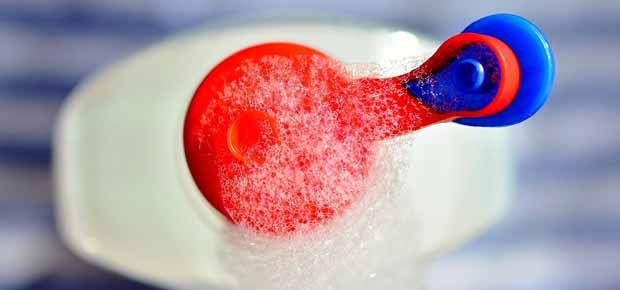Also known as surfactants, surface-active agents are basic cleaning agents in soaps and detergents. These agents are added to wash water to lower its surface tension, thereby to increase the wetting and spreading properties of water. Surfactants are usually organic compounds, which are amphiphilic, meaning they are soluble in both organic solvents and water. Surface active agents have two parts, one is hydrophilic (water loving) and another is hydrophobic (water repellent). Surface-active molecules concentrate at the areas of contact or interfaces, between oil and water. One end of the molecule seeks oil, while the other end seeks water. At the interface of water and oil, surface-active agents emulsify oil and mix it into the liquid in the same way fat is mixed in milk. At the interface of water, these agents trap air molecules to produce foam.
By reducing the surface tension water, surfactants improve the cleaning performance by enabling the solution to wet a surface (for example, dishes, clothes, and countertops) quickly and effectively, and hence the soil can be readily loosened and removed. Surface active agents also emulsify oily soils and keep them suspended and dispersed so they do not settle back on the surface. To achieve superior cleaning performance, most of the cleaning products contain two or more surfactants.
Surfactants are generally classified on the basis of their ionic properties (electric charge) in water. On the basis of ionic properties, surfactants can be classified into four types -
The molecular structure of surface-active agents means that they have unusual characteristics, leading to their uses in widespread and highly specialized applications. The properties of these agents can be categorized into two types -

Structures of Common Surfactants Used in Biochemistry
Adsorption is the tendency of the molecule of a surfactant to collect as an interface. It is the taking up of a liquid or gas at the surface of substance, generally a solid (for example, activated charcoal adsorbs gases). The process involves molecular attraction at the surface.
The adsorption property of surfactants mean that their molecules are generally found at the interface between a water phase and an oil phase an air phase and a water phase. This molecular property results in the macroscopic properties of wetting, detergency, foaming and emulsion formation. The molecules of a surface-active agent tend to adsorb to the surface of oil droplets. While the hydrophilic heads stick out into the water phase, the hydrophobic tails stick into the oil phase.
Self-assembly is the inclination of surfactant molecules to organize and coordinate themselves into the extended structures in water. The process includes the formation of micelles, liquid crystals and bilayers that are formed when the hydrophobic tails of surfactant molecules cluster together to produce small aggregates, like micelles, or large layer structures like bilayers that are similar to a cell wall. These characteristics of surfactants make them an interesting study and an area of research.
Surfactants can also organize to form micelles, which allows the
hydrophobic tails to get out of the water, however it still allows the
hydrophilic heads to stay in the water. There is typically between a few
dozen to a couple of hundred surfactant molecules in a micelle.
Surfactants also aggregate to develop and produce extended structures in water like that of surfactant bilayers.
The concentration at which surfactants start forming micelles is known as the critical micelle concentration or CMC. When micelles are formed in water, their tails form a core, which can encapsulate an oil droplet, and their (ionic/polar) heads produce an outer shell, which maintains a favorable contact with water. When the surfactants assemble in oil, their aggregate is referred to as reverse micelle. In a reverse micelle, the heads remain in the core and the tails maintain a favorable contact with the oil.
Thermodynamics of surface-active agents is of great importance theoretically as well as practically. This is due to the fact that these agents represent systems between the ordered and disordered states of matter.
The surfactants have found variety of uses and applications in the detergent industry, in emulsification, lubrication, catalysis, tertiary oil recovery, and in drug delivery. Some of the important applications of surfactants include -

If you have decided to make soap at home, you will need soap making supplies in the form of raw materials, soap making equipment & tools ...
Read More
Someone has rightly said that clothes are not just clothes. They form an integral part of a person's personality and tell a lot about their nature and...
Read MoreCleansing products play an important role in the daily lives of people.
Both soaps and detergents are cleansing products that we frequently use in our
Soap is designed as a product to be used once and then flushed down the drain...